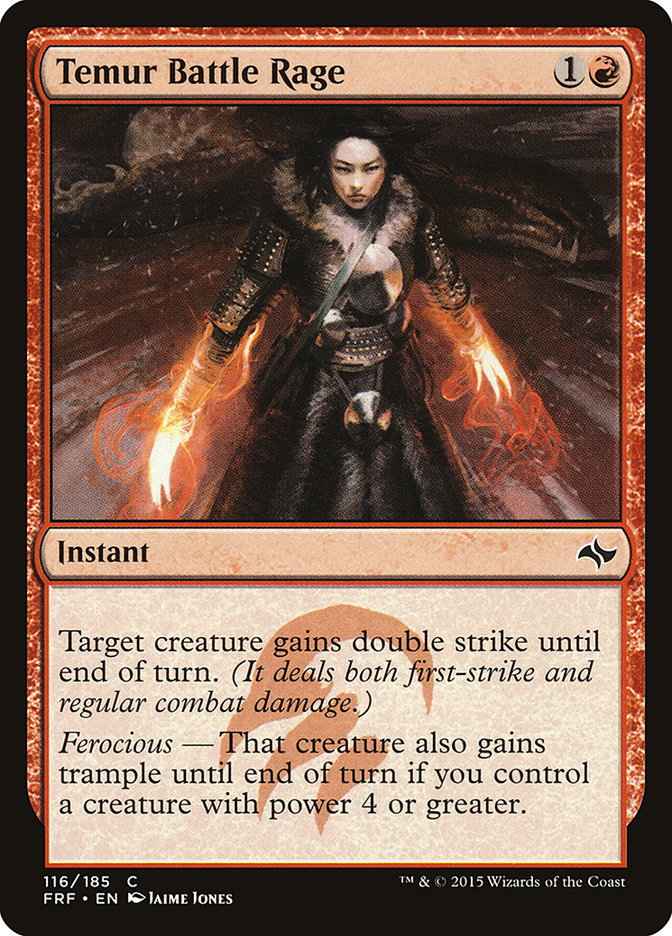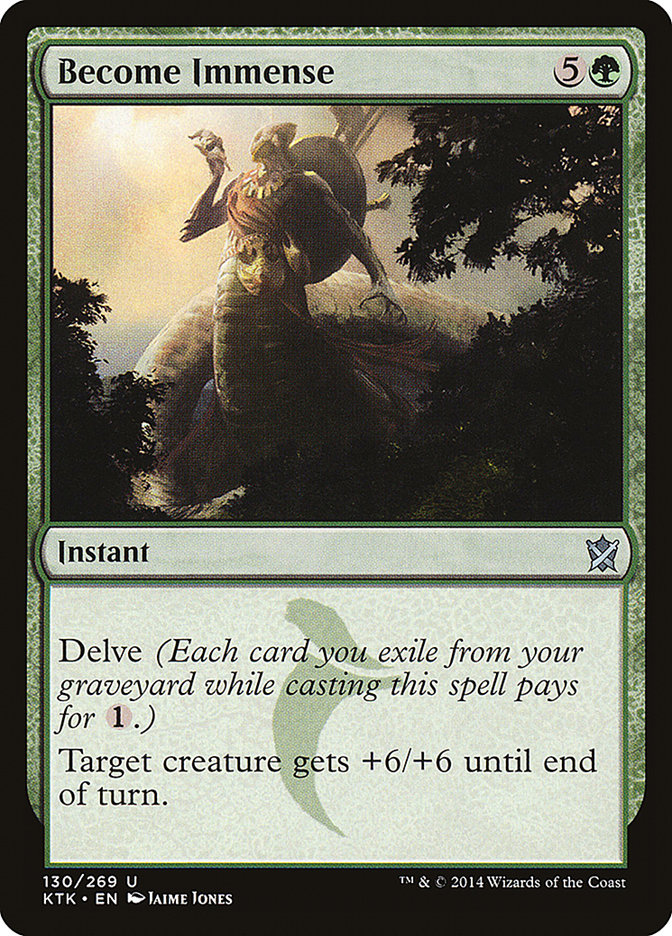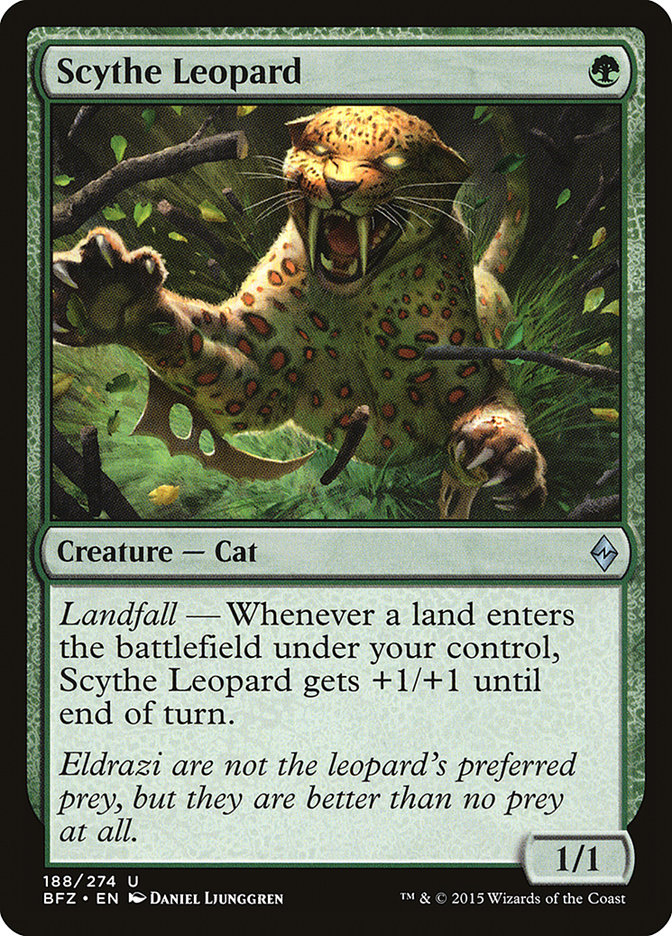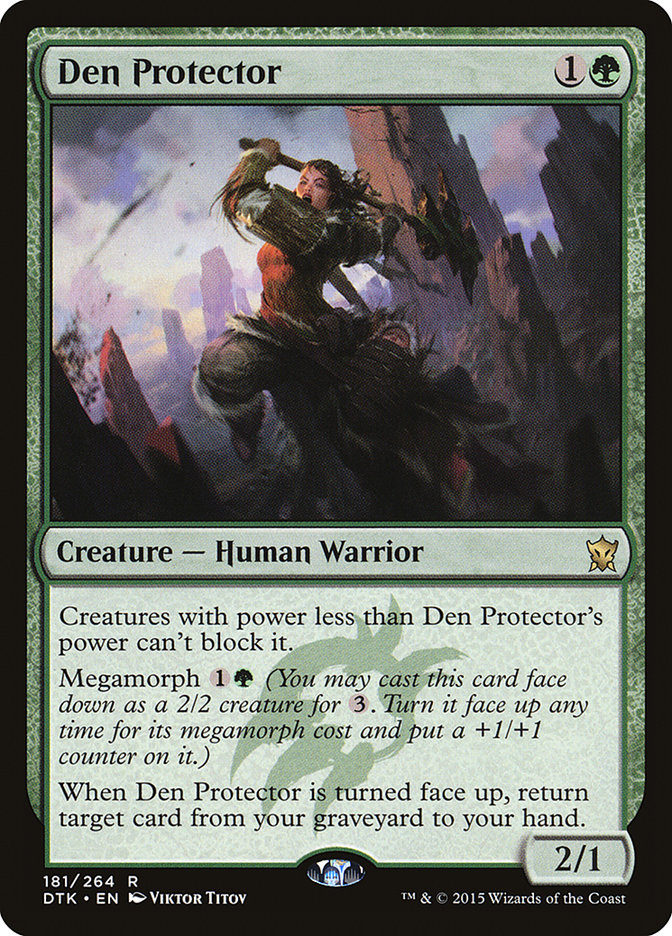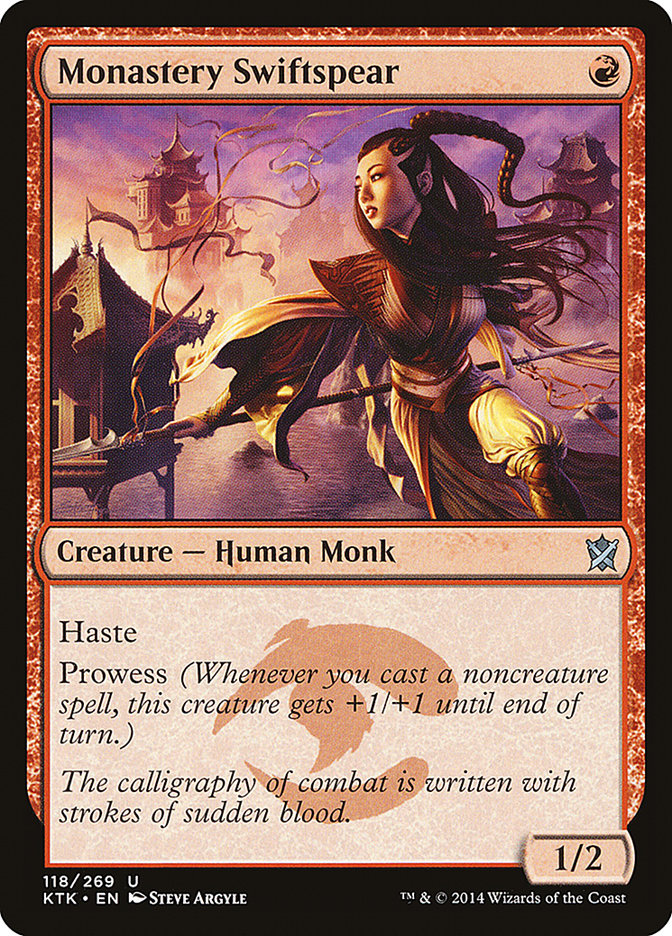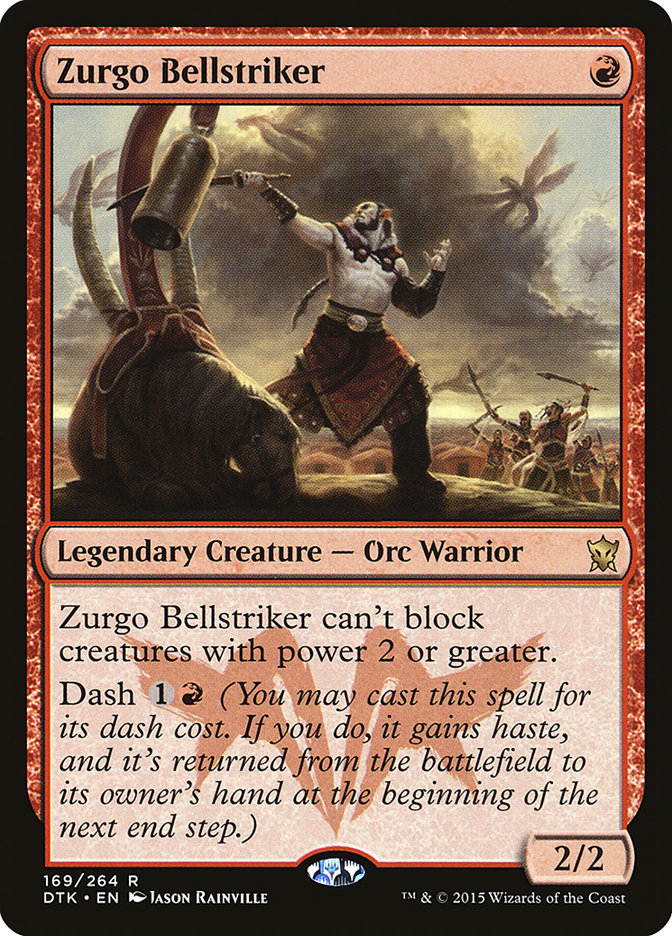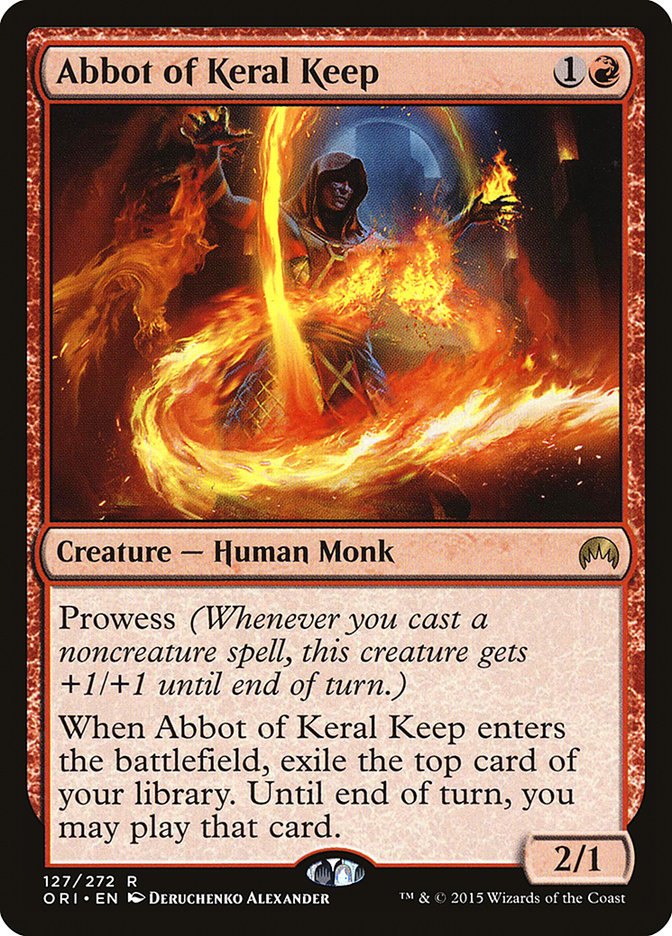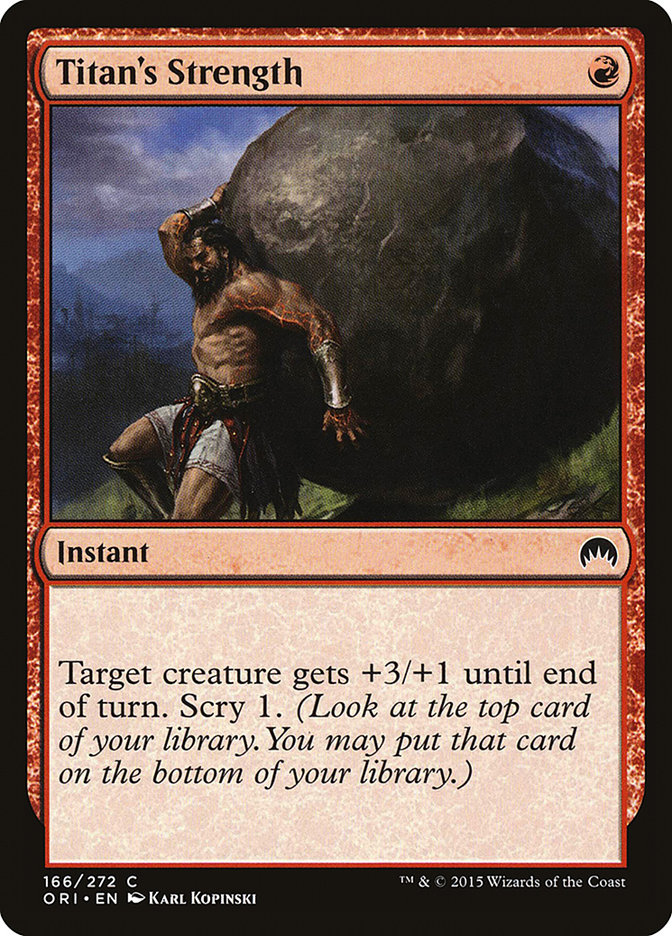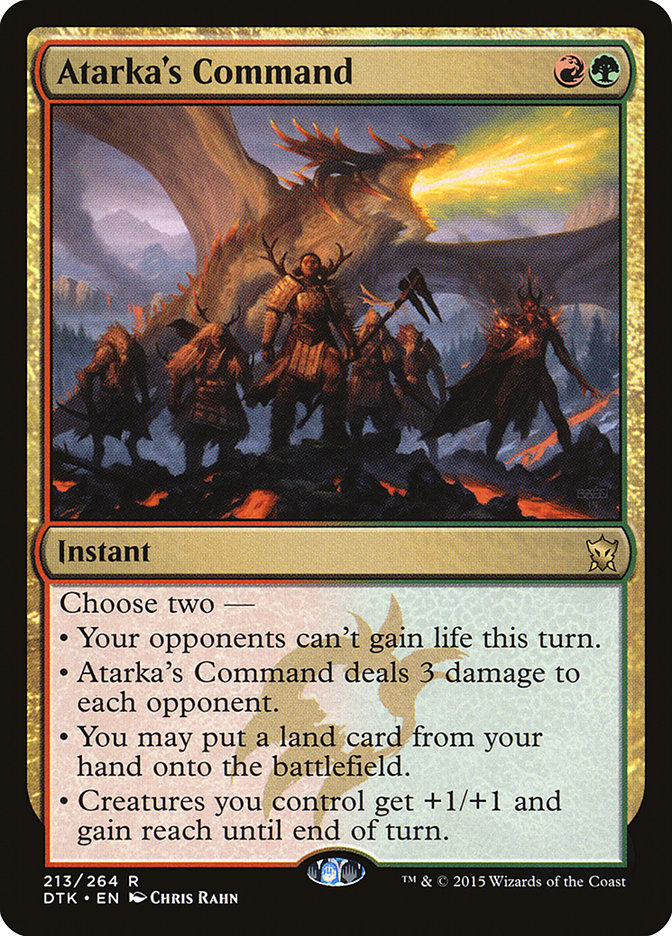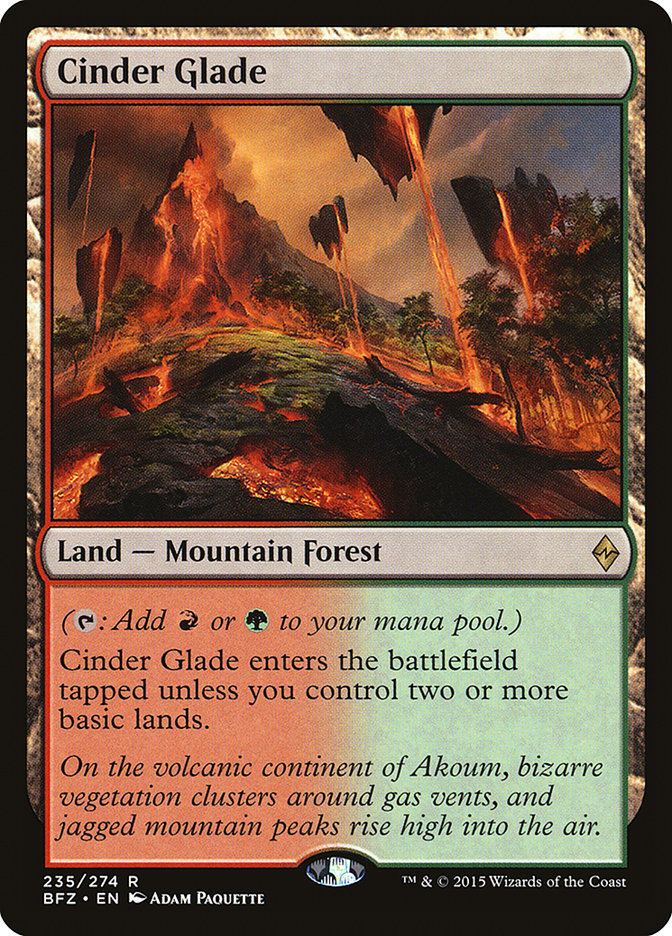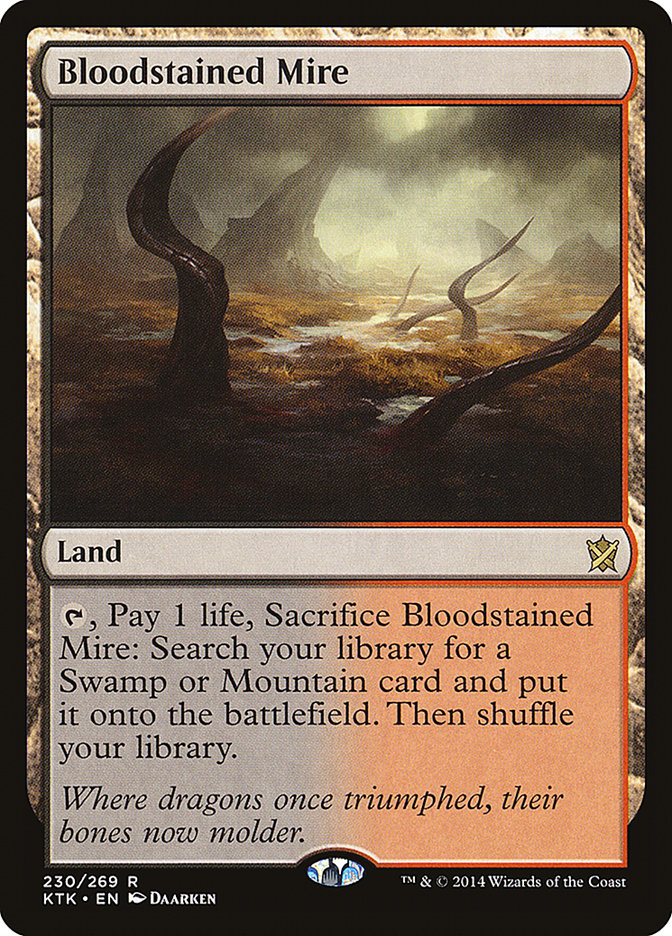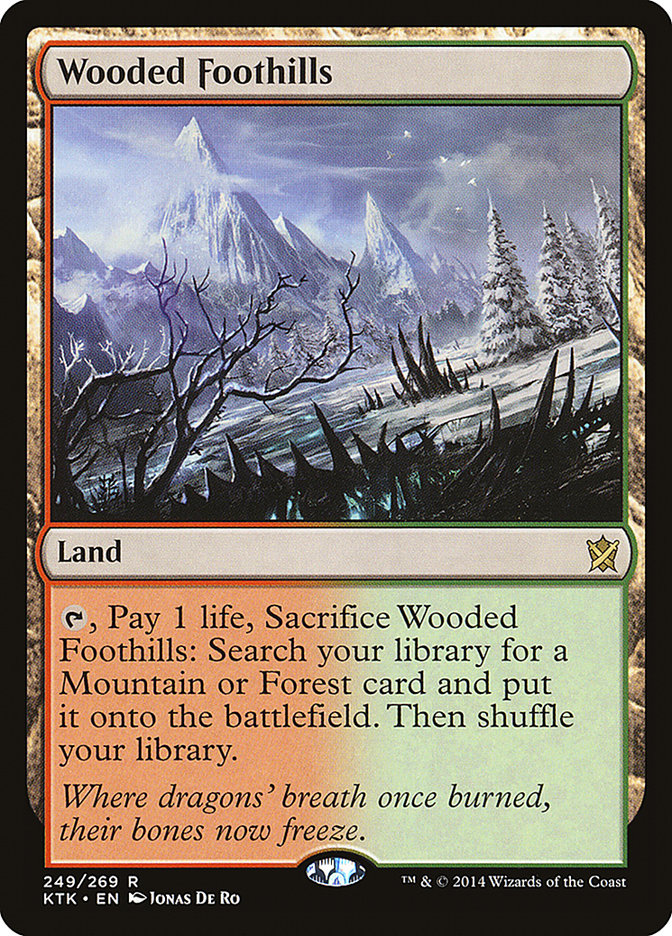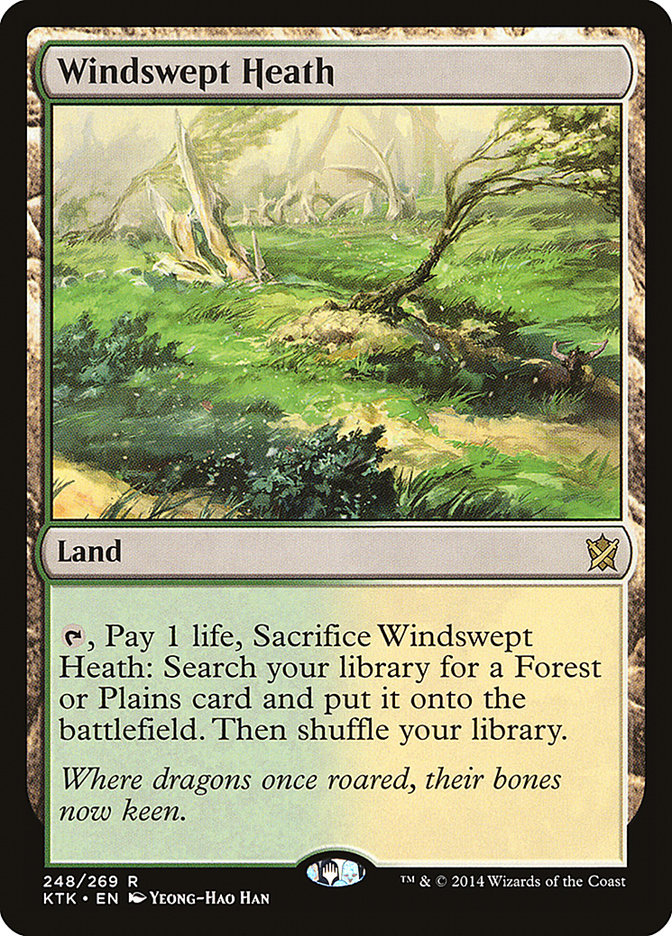Despite my sub-mediocre finish at Pro Tour Battle for Zendikar, I was actually playing one of the best decks in the room. Not only was it explosive and
capable of winning the game on turn 3 or 4, it was also super resilient to a lot of the things people lean on to combat decks like it. Nine of us played
the deck and we put up two 8-2 and two 7-3 finishes. After Day One, we had almost a 75% win rate with the deck, and while it definitely dropped over the
whole event, it was easily among the highest in the field.
Creatures (20)
- 4 Monastery Swiftspear
- 1 Zurgo Bellstriker
- 4 Den Protector
- 4 Abbot of Keral Keep
- 4 Scythe Leopard
- 3 Snapping Gnarlid
Lands (24)
Spells (16)

One note: I registered 5 Forests, 0 Evolving Wilds at the Pro Tour. I’m not sure which is right, but I definitely felt light on fetchlands at points and
would want to try the one Evolving Wilds moving forward.
What Is Landfall Doing?
Combo-aggro is a really strange archetype that doesn’t come up often, but when it’s good, it’s extremely powerful. Some classic (read: ancient) examples
are the Patriarch’s Bidding Goblin deck and Disciple of the Vault + Arcbound Ravager Affinity decks from Standard formats around a decade ago. Both played
normal aggro games, but had some big lethal finish from a single card pairing that could negate position discrepancies that traditional aggro decks
sometimes struggled trying to maneuver out of.
As evidenced by Brian DeMars’ win at #SCGINDY a couple weeks ago, the new school Blood Lust + Berserk combo of Temur Battle Rage and Become Immense is
really good. People just die out of nowhere if you have it. Heck, the combo is even Modern playable!
An important part of why the combo is good is that Become Immense is just a good card on its own. Most of the time it’s a one-card, six damage spell. Going
back to raw Philosophy of Fire, that’s a pretty insane rate. The
most messed up part of the card is that it is an absurdly mana efficient six damage, mostly because delve is just comically broken.
The problem with the traditional Atarka Red decks is that the Temur Battle Rage half of the combo is just bad. Your deck is a bunch of stupid 1/1 Goblin
tokens, which double strike up to…. dealing two damage. Last I checked, 1R deal one damage is not Constructed playable. Sure, you can also combo with
Titan’s Strength or prowess-triggered Abbot of Keral Keep to deal 3-6 extra, but it’s not the best. This is why you saw Brian DeMars only playing three
Battle Rage and why Paulo Vitor Damo Da Rosa also only played three in his Pro Tour top 8 deck. The card isn’t good outside of the combo, and in turn,
multiples are really hard to utilize.
Enter the landfall creatures. All of these can easily get to four+ power (Scythe Leopard via an existing fetch plus playing another), so Temur Battle Rage
is easily capable of dealing a significant amount of damage without a second spell to assist it. Now that multiple copies can be used well, you can go up
to four copies and combo more reliably. This means a lot of really messed up draws that just kill your opponent on turn 4, or even turn 3 can occur, which
is always great at a Pro Tour when people aren’t necessarily ready for all the ways you can prevent them from being able to play Magic.
The landfall creatures also promote playing a more consistent deck. Not only do they have a higher per card power level than something like Dragon Fodder,
allowing you to combat flood by just bashing them with less cards, but they incentivize playing more lands, combating some of the mana screw issues Atarka
Red has. You do stretch to a solid two-color manabase, which has traditionally been awkward for aggro, but we live in fetchland + Battle land Standard
where nothing matters and you can do basically anything you want in a two-color deck because you play fourteen copies of Taiga.
Den Protector is another part of the combo in a few different ways. First is that you can set up double pumps with the Den Protector flip trigger to “short
combo” your opponent in the lategame (ie. Titan’s Strength, flip, recast, jam for nine). The other convenient part is that Den Protector is the evasion
part of the short combo. Odds are that when you execute that Titan’s Strength line or even just jam a Become Immense on your Den Protector, your opponent
is not going to have some massive Eldrazi-sized creature that can get in the way. Wandering Wolf never looked so good.
The card also provides a lot of lategame power and sideboard power like it does in any deck, allowing you to rebuild a threatening board via Den Protector
or Abbot chains, or just rebuying your sideboard answers to maximize their effectiveness.
As you may notice, we opted to play zero copies of Makindi Sliderunner despite the built-in trample seeming extremely attractive if you are a Become
Immense deck. Snapping Gnarlid is certainly worse when you are straight up goldfishing, but it has a lot of subtle interactions that make it the better
card.
The biggest one is the extra toughness, which adds a shocking amount of value. You can just play a fetchland and jam into a Mantis Rider with your 4/4,
then leave up the fetchland when they don’t block to dodge Wild Slash. You can have a fetchland up, play another, and jam into a Siege Rhino threatening to
be a 5/5. Your two ready fetches saves your Gnarlid from a three damage Radiant Flames, and an unused fetch plus Atarka’s Command dropping another
fetchland lets Gnarlid survive a Languish. Even just blocking a Goblin token or eating another point off of an Arc Lighting really swings the Atarka Red
matchup.
The other reason is really important in the sideboard games. Your deck actually plays more green creatures (Scythe Leopard, Snapping Gnarlid, Den
Protector) than red ones (Zurgo, Monastery Swiftspear, Abbot of Keral Keep). Everyone at this event was trying to beat Atarka Red by sideboarding in Surge
of Righteousness to break up the combo. Too often they would be sitting with their conditional removal spell in hand unable to kill the massive double
striking Den Protector that was dealing well beyond lethal. You are preboarded to create sideboard mismatches.
Technical Notes
This deck is one of the more technically difficult decks I’ve played in the last couple years. There’s a lot of extracting value from each card while doing
math for delve and counting to lethal. Here’s my cheat sheet of notes on each card, mostly learned from playing the deck and messing up.
-Remember all the numbers on this card just to make things take less mental energy. Titan’s Strength is 5/4, Temur Battle Rage after is 6/5 for twelve
damage. Become Immense is 8/9 and 9/10 for eighteen damage in the same situations. Atarka’s Command with the pump mode is 3/4, which means you beat a
Mantis Rider and survive Radiant Flames.
-Against decks with Languish or similar effects, slow rolling a haste creature to combo when they tap out is a strong option if your curve allows it.
Skipping a turn 1 play to do this is bad, but when deciding what threats to extend after, keep this in mind.
-See the second point about Swiftspear and haste.
-Saving a fetchland plus playing a fresh one makes this a 4/4 to run over Mantis Rider and ferocious a small Temur Battle Rage.
-It is very hard to make this card survive Radiant Flames without using Atarka’s Command as instant speed pump. It usually is not worth trying.
-You can keep Leopard under Abzan Charm by not double landfalling into open mana if you think your opponent is likely to be forced to tap out in a
non-punishing way (ie. Not Languishing all your stuff away without you hasting them back).
-Saving a fetchland plus playing another one makes your Gnarlid a 5/5 to beat a Siege Rhino. This is very relevant in the matchup.
-Saving Gnarlid from a sweeper is much easier than saving Leopard. If your board presence is stalled through a spot removal spell, this is a very
reasonable play if you suspect their plan revolved around it and you can immediately punish the tap out (or if you just need to save your last
creature to bash them).
-Do not be afraid to just run this card out there for no value if you need to get on board. You are a red deck. The extra card off Abbot is the bonus for
having it later, not the base effect of the card.
-As with Swiftspear, know the prowess math. Titan’s Strength is 6/3, Temur Battle Rage follow up for 7/4 dealing fourteen. Become Immense is 9/8, Battle
Rage makes it a 10/9 dealing twenty. Atarka’s Command makes Abbot into a 4/3, so you need to be doing something like using a Titan’s Strength elsewhere to
save it from Radiant Flames. How convenient, you sometimes don’t want to overextend early with your harder to protect threat that gets value later!
-Double prowess’ed or single Titan’s Strength’ed Abbot being an X/3 comes up against Valorous Stance on occasion.
-You aren’t required to cast the card Abbot exiles. The usual case of this is exiling a basic land when you need to play your in-hand fetchland to hit
relevant landfall or delve numbers.
-If this exiles a Cinder Glade that you don’t play, don’t forget that this may limit your fetch options later. I lost a game at the Pro Tour this way.
-As with Abbot, don’t be afraid to play this as a Wandering Wolf. Again, you are a red deck. You need to be attacking. Similarly, don’t be afraid to play
this as a morph without 1G up if you absolutely need the Regrowth value.
-This is one of your best weapons against Arashin Cleric. Nice 1/3 that can’t block my creatures.
-Starting from a face-down Den Protector, looping an in-hand Become Immense costs 1GGG plus twelve mana or cards in graveyard. I have done it. More common
is looping Titan’s Strength for 1GRR and nine damage.
-Remember that casting this spell on upkeep to scry is a thing. The most common use of this is in an end game situation where you are trying to topdeck the
next spell to lethal on your one open turn. This play is rare early on, as using the mana often prevents you from playing a spell off the top that advances
your board.
-Just running this out there as Lava Spike with scry 1 happens a fair amount. If you are just going to sit on it to play for the same damage later,
consider just using it to get the scry value in earlier and fill your graveyard.
-There are often draws with this card, a one-drop, no two, and a Become Immense where you are better off cashing this in for four damage on turn 2, so you
get the virtual Lotus Petal from delving it away in the near future.
-As mentioned many times, using the landfall mode on this card comes up on occasion. More so for the “pump on your turn to counter a sweeper” and less for
the “extra pump on this attack.”
-There are a lot of Dispels and other things in this format. Know how to slow roll your lethal burn spell to play around them and when you won’t be able to
do so and need to give your opponent no extra draws to find one.
-Delve is dumb and the most fundamentally broken mechanic since the last time they let you convert a resource for mana (Phyrexian mana). Just saying it
again because it’s worth repeating. Affinity for Dredge.
-If you are going for the aggressive kill, remember to take actions that fill your graveyard if needed.
-Remember that chump blocking or even chump attacking to generate future delve mana is a thing you can do in cases where you are short on mana but long on
random idiots stuck on the battlefield.
–Become Immense overrides a lot of removal that is size-based like Dromoka’s Command and Complete Disregard. Just remember if you plan on inducing the
removal spell with a first trick then re-tricking over it that your original spell will still be on the stack and can’t be exiled to delve.
-Playing two Become Immense in one turn lets you exile the first one to play the second. Yes, resolving two Become Immense is just as awesome as it sounds.
-You can cast your Temur Battle Rage before your Become Immense so that you can exile your Battle Rage to delve. This is how most of the turn 3 kills
involving the combo occur: three fetches, an Atarka’s Command or a Titan’s Strength, and the combo on your one-drop.
-You don’t get the ferocious bonus if your creatures are small and your pump spell resolves after your Temur Battle Rage. This sounds like I’m literally
quoting the card text, but it’s easy to forget sometimes.
-This is one of your best weapons against Deathmist Raptor. Blocking a 4/X with a Raptor often results in a dead Raptor and your opponent taking five
trample damage.
-This card still grants trample to a smaller target as long as one of your other creatures is ferocious. This isn’t especially common but can come up on
boards with Snapping Gnarlid and Scythe Leopard attacking into a 3/3.
-Your deck functions because this card exists. Without it, the two colors of one-drops would be fairly unreliable. Sometimes you have to take your first
turn off to make things work, that’s just life. Just be thankful that the mana in this format is broken enough to let two-color decks play split one-drops,
curve Deathmist Raptor into Archangel of Tithes while splashing countermagic, or let three- to four- color decks play any spells that don’t cost two of the
same color.
-If you can use a Mire or Heath instead of a Foothills, you should do so to leave your basic land fetching options open.
-Finding the third red source matters more than the third green, usually due to Abbot, but by that point you probably can do anything you want.
-This deck exists partially because everyone else is starting the game down 2-4 life from their fetchlands every game. A lot of your random kills are just
a little bit cleaner due to that small edge gained. If things change and somehow decks exist that are fast enough to interact with you and start at 19-20
life each game like normal Magic, you may want to consider not playing red cards for a while.
The Sideboard Packages
This card exists almost solely to trump G/W Megamorph and other decks that try to stop you onboard without access to Wild Slash. It’s green to dodge Surge
of Righteousness and makes combat impossible for them. They can’t attack or block well as long as you can spend mana on the Threaten trigger. The card that
this almost completely blanks is Archangel of Tithes. Even though that card is usually beatable in the heads up fight, as you are attacking with only a
couple creatures a turn, Threatening it usually means your opponent did nothing on their turn or can’t block. Both of these are acceptable outcomes.
Usually when Yasova comes in, Zurgo comes out, as it is trash in creature brawls. The last cut can really be a number of things depending on how you feel
like approaching the games.
This card is not super important. G/W is already a reasonably good matchup that is just solidified by access to Yasova. If you need some number of Roast or
Goblin Heelcutter to combat the rise in Anafenza, the Foremost and Siege Rhinos after those cards won the Pro Tour, this is where I would start looking for
slots.
Note: You choose your target when the trigger goes on the stack, then pay when it resolves. If your opponent responds, you don’t have follow through with
paying.
0-3 Burn spells
This is the anti-control package. You trim heavily on Temur Battle Rage and lightly on pump to play a game with stronger followup threats to a Wrath
effect. Some burn can replace Titan’s Strengths so that you don’t need a creature on the battlefield to close, but you rarely cut more than one Become
Immense because the rate on that card is so good.
Worth noting: I don’t know if the control decks moving forward will be Dragonlord Ojutai-based or lean on non-Crackling Doom-able threats like Ob Nixilis
Reignited. If they have Ojutai and Jace, Vryn’s Prodigy, it’s possible boarding in Rending Volley over the random burn is good.
This is the plan against people who are going to overload on removal backed by tempo threats. Typically this means Jeskai, but if your Jund opponent
follows this plan, do the same thing with no Rending Volley. Again you are sideboarding out a lot of the pump spells that require you to walk into a
two-for-one, but on top of that, some Atarka’s Commands go. You are leveraging each of your threats for maximum value here, answering theirs, and riding a
Sarkhan or Outpost Siege to incremental advantage. Emphasis here is on the Siege part, as landing that card sooner rather than later is best.
Cool trick: If you have both Sarkhans with one already on the battlefield at five loyalty, you can +1 the first to make it a non-planeswalker Dragon, play
the second, and -3 to kill their Mantis Rider before bashing them. Just remember to turn the first Sarkhan into a creature first.
I also have no idea what happens if you ultimate Sarkhan. Please let me know if you find out, as they usually just die instead of giving me the chance.
This is the plan in low to the ground aggro mirrors. Atarka’s Command goes, as you aren’t going wide or chipping in the win, while the full combo stays so
you can just nut draw when you have it. Depending on play or draw, you can shave some of the slower threats or Scythe Leopards to make their Arc Lightnings
worse. If you feel like things might get too grindy, adding a Siege or two also makes sense.
Nothing
This is the plan against decks that you can’t grind down with Outpost Siege and whose threats you can’t really kill. Sometimes this is Jeskai if they have
too much Hangarback Walker nonsense going on, sometimes this is Siege Rhinos. These are people who will tap out against you. Shuffle in fifteen, remove the
same fifteen, present, and just KO them.
R/G Landfall is definitely the top aggro deck of the current Standard format. While things may balance out as people adjust their answers, it’s hard to
argue with the raw power it presents. I have no idea who decided it was okay to let people die on turn 3 in Standard, but I expect it will keep happening
as long as Temur Battle Rage and Become Immense are legal together.

